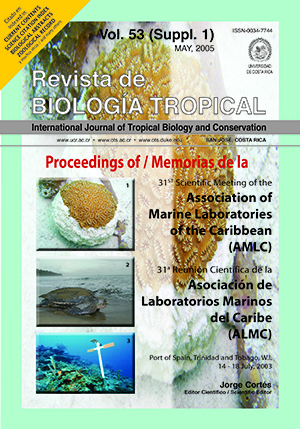Abstract
The marine ornamental fish trade began in the 1930s in Sri Lanka, spread to Hawaii and the Philippines in the 1950s, and expanded to a multi-million dollar industry in the 1970s with fisheries established throughout the tropical Pacific, Indian and Atlantic Oceans. Currently, 45 countries supply global markets an estimated 14-30 million fish annually, with an import value of US$28-44 million. The largest suppliers are Indonesia and the Philippines, followed by Brazil, Maldives, Vietnam, Sri Lanka and Hawaii. In the tropical Western Atlantic, 16 countries have export fisheries, including the U.S. (Florida and Puerto Rico). The U.S. is the world’s largest buyer, followed by the European Union and Japan. The global trade consists of over 1400 species of reef fishes, of which only about 25 are captive bred on a commercial scale. Damselfish, anemonefish, and angelfish constitute over 50% of the global volume; butterflyfish, wrasses, blennies, gobies, triggerfish, filefish, hawkfishes, groupers and basselets account for 31% of the trade, and the remaining 16% is represented by 33 families. The most important fishes from the Caribbean are angelfish (six species), seahorses (two species), royal gramma, jawfish, queen triggerfish, redlip blenny, puddingwife, bluehead wrasse, and blue chromis. The Caribbean currently supplies a small percentage of the global trade in marine ornamental species, but ornamental fisheries in this region represent important emerging industries. It is critical that effective ornamental fishery management plans and regulations are developed and enforced, and fishery-dependent and fishery-independent data are collected and utilized in decision making processes to ensure sustainable ornamental fisheries throughout the region.References
Anonymous. 2002. The United States consumption of ornamental fish: a preliminary analysis of import data. World Resources Institute, NOAA Final Report. 47 p.
Armstrong, J. & J. Crawford. 1998. Convention of International Trade in Endangered Species of Wild Fauna and Flora. p. 65-67. In M.E Hatziolos, A.J. Hooten & M. Fodor (eds.). Coral reefs: Challenges and opportunities for sustainable management. Proc. of an Associated Event of the Fifth Annual World Bank Conference on Environmentally and Socially Sustainable Development, Oct. 9-11, 1997. The World Bank, Washington, DC.
Barber, C.V. & V.R. Pratt. 1998. Poison and profits: cyanide fishing in the Indo-Pacific. Environment 40: 6-34.
Bruckner, A.W. 2003. Sustainable Management Guidelines for Stony Coral Fisheries. p 167-184. In J. Cato & C. Brown (eds.). Marine ornamental species collection, culture and conservation. Blackwell Scientific. Iowa State University Press, Iowa.
Green, E.P. & H. Hendry. 1999. Is CITES an effective tool for monitoring trade in corals? Coral Reefs 18: 403-407.
Johannes, R.E. & M. Riepen. 1995. Environmental, economic and social implications of the live reef fish trade in Asia and the Western Pacific. Report to the Nature Conservancy and the South Pacific Commission. Bonnet Hill, Tasmania Australia. 83 p.
Lathrop, C. & T. Hourigan. 1998. The United States and the live reef fish trade: trade-based solutions to cyanide fishing in the Asia-Pacific Region. p. 190-199. In Asia-Pacific Economic Cooperation Marine Resources Conservation Working Group (ed.). Proceedings of the Workshop on the Impacts of Destructive Fishing Practices on the Marine Environment 16-18 December, 1997. Agriculture and Fisheries Department, Hong Kong, China.
Miyasaka, A. 1994. Status Report: Aquarium Fish Collections. Fiscal Year 1993-94. Division of Aquatic Resources, Department of Land and Natural Resources, State of Hawaii, Honolulu. 8 p.
Rubec, P.J., F. Cruz, V. Pratt, R. Oellers, B. McCullough & F. Lallo. 2001. Cyanide-free, net-caught fish for the Marine Aquarium Trade. Secretary of the Pacific Community (SPC) Live Reef Fish Info. Bull. 7: 28-34.
Rev. Biol. Trop. (Int. J. Trop. Biol. ISSN-0034-7744) Vol. 53 (Suppl. 1): 127-138, May 2005 (www.tropiweb.com) 137
Sadovy, S. 1992. A preliminary assessment of the marine aquarium export trade in Puerto Rico. Proc. 7th Int. Coral Reef Symp., Guam 2: 1014-1022.
Sadovy, Y.J. & A.C.J. Vincent. 2002. Ecological issues and the trades in live reef fishes. p. 391-420. In P.F. Sale (ed.). Coral Reef Fishes: Dynamics and Diversity in a Complex Ecosystem. Academic Press, San Diego, California.
Tissot, B.N. & L.E. Hallacher. 1999. Impact of aquarium collectors on reef fishes in Kona, Hawaii. Final report, Department of Land and Natural Resources, State of Hawaii, Honolulu, HI. 32 p.
Vallejo, B. 1997. Survey and review of the Philippine marine aquarium fishery industry. Sea Wind. 11: 2-16.
Wabnitz, C, M. Taylor, E. Green & T Razak. 2003. From Ocean to Aquarium. UNEP-WCMC, Cambribge, U.K. 64 p.
Wood, E.M. 2001. Collection of coral reef fish for aquaria: Global trade, conservation issues and management strategies. Marine Conservation Society, Ross-on-Wye, UK. 80 p.
Anonymous. 2003. FishBase. R. Froese & D. Pauly (eds.). (Downloaded: September 24, 2003, http//:www.fishbase.org).
##plugins.facebook.comentarios##

This work is licensed under a Creative Commons Attribution 4.0 International License.
Copyright (c) 2005 Revista de Biología Tropical






